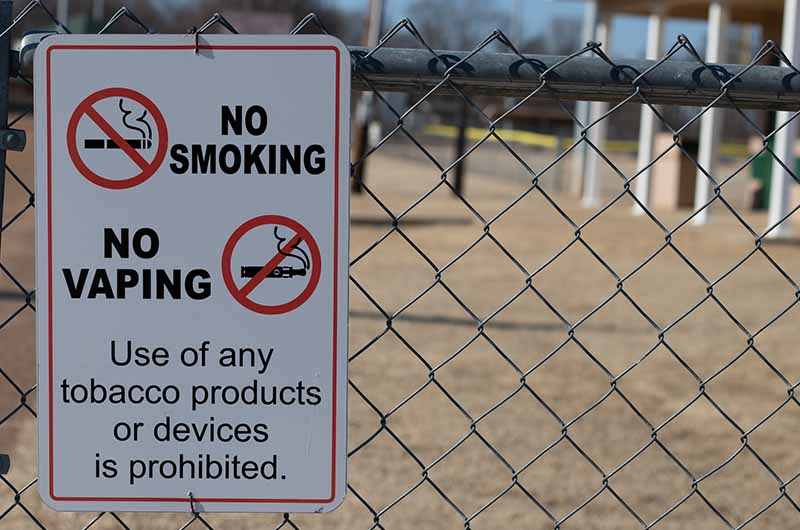The fight against youth vaping: Programs, research and school strategies

As we head into another school year, educators and health experts are ramping up for the latest round in the fight against vaping. Over the last few years, they’ve made headway on the issue, but research continues to uncover vaping’s ill effects.
After decades of progress in reducing cigarette smoking among young people, research suggests that teens who vape may smoke later. According to a scientific statement from the American Heart Association, using e-cigarettes can raise your chances of getting asthma. Vaping can also lead to lung problems, make arteries harden, increase blood pressure and cause trouble sleeping. Just being near someone who is vaping and breathing in the aerosol they produce could also be dangerous.
Studies reveal that vaping is pervasive in a young person’s surroundings. According to a 2021 CDC survey, almost 60% of middle and high school students in the U.S. said they first tried e-cigarettes because they saw a friend using them. Most young people got e-cigarettes from friends, with family members also being a frequent source.
In addition, the FDA’s 2023 National Youth Tobacco Survey reported 2.13 million middle and high school students using e-cigarettes.
A constellation of efforts
Since 2018, the FDA has been working to lower e-cigarette use among young people through its public education efforts. Their Real Cost E-Cigarette Prevention Campaign uses different media – such as TV, digital platforms, social media and gaming – to reach teens. The campaign provides tools to help quit and offers educational materials through partnerships with organizations such as the National Cancer Institute and the Vaping Prevention and Education Resource Center. They use research to improve their strategies and track their effectiveness, with recent data showing that 67% of teens saw at least one ad and 37% recognized the campaign.
Several other national anti-vaping programs are showing promising results in research. These include:
- smokeSCREEN: This video game teaches kids about the dangers of e-cigarettes and other tobacco products, aiming to help them avoid using these products altogether. Researchers at Yale University created it.
- This is Quitting: This program sends automated daily text messages to people ages 13 through 24, featuring advice and encouragement from peers who have tried or successfully quit using e-cigarettes. It was developed by the public health nonprofit Truth Initiative.
- CATCH My Breath: Developed at the University of Texas Health Science Center in Houston, CATCH My Breath offers educational resources for parents and classrooms. These include group discussions, goal setting, and activities. The program also provides schools with digital materials, such as teaching guides, presentations and posters tailored to different age groups, some of which are free and others available for purchase.
Meanwhile, the American Heart Association is funding up to $20 million for research on e-cigarettes’ effects on youth, aiming to address the growing nicotine addiction problem among children and teens. Key research projects include interventions for e-cigarette use, studying health impacts and developing new cessation programs to help young people quit vaping.
Boston University’s Rapidly Advancing Discovery to Arrest the Outbreak of Youth Vaping Center is developing and testing a virtual reality program to help high school students quit or avoid vaping. Led by principal investigator Belinda Borrelli, the team uses student feedback on current cessation programs to create an engaging virtual reality intervention that schools can implement. She says, "We need to think about overall public health strategies for regulation that are going to reduce combustible cigarette use as the No. 1 goal and limit or stop [all nicotine product use].”
Teaching through support
Meanwhile, schools are starting to shift their approach to nipping nicotine use in the bud. Jackie Michalski, class assistant principal at Shenendehowa High School East in Clifton Park, New York, and her team have been working to educate students and parents about the risks of e-cigarettes and tobacco.
The school shifted its approach for students caught vaping from punishment to support. Instead of a one-day suspension, the school refers students to counselors who help them understand the addictive nature of vaping and develop strategies to quit. “The counselors are part of the team approach we have,” Michalski said.
Shenendehowa High also piloted a program in which students caught vaping read articles and wrote essays on vaping’s risks to foster behavioral change. They also hosted informational sessions aimed at helping parents spot signs of vaping, such as increased thirst, nosebleeds and unusual scents.
While educators, researchers, health experts and advocates have made big strides in raising awareness and developing innovative prevention programs, the fight against vaping is far from over. By combining effective prevention strategies, comprehensive support systems and ongoing research, we can work towards turning the tide on this critical public health challenge.





